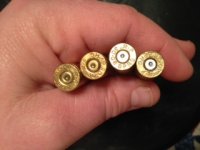This may seem a little basic, but I haven't seen one of these before and I need someone to tell me what is going on with these primers.
First off, I did not do these reloads. Therefore, I do not know any brands of the primers in question, but there looks to be two different primers based on color.
The two 'silver' primers appear to have the same indention. The two 'gold' primers are the odd balls.
If anyone can tell me what they think happened, I'd appreciate it.
Robert
First off, I did not do these reloads. Therefore, I do not know any brands of the primers in question, but there looks to be two different primers based on color.
The two 'silver' primers appear to have the same indention. The two 'gold' primers are the odd balls.
If anyone can tell me what they think happened, I'd appreciate it.
Robert


